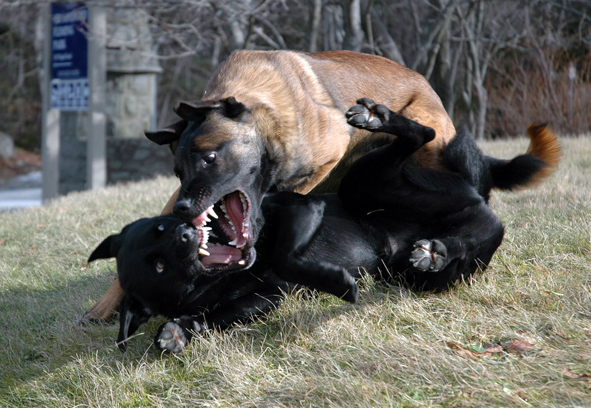The generalization of fear: Over compensating aggression.
What you are about to read is absolutely not going to be received well in the dog community. It goes against everything most dog trainers and dog professionals have thought and taught for years. Allow me an ear while I unpack a concept that may change the way you think about the vast majority of aggression seen in dogs.
Many dog professionals believe that the vast majority of aggression seen in dogs is fear aggression. Five years ago I also believed that. Some have even gone to such an extreme to say that all aggression is fear based. I have absolutely no idea how anyone could come to that conclusion, given predatory aggression and dogs that kill other dogs, but that is besides the point.

Looks can and will be deceiving. These are two of my dogs, they are playing and have never been in a fight.
Outward aggression must have confidence.
I work with dogs who have been deemed fear aggression cases by other trainers every day. Please explain to me how such a dog can go out of its comfort zone, run across a soccer field, attack and pin down a dog, leave holes in its neck, and still be deemed fear aggressive?
Maybe I’m missing something?
I get it, a lot of dogs go to dog parks, the owners may or may not be paying attention and then a dog decides to defend himself. Very little time in dog parks is spent advocating to the sensitive dog. That my friends is a shame because true fear aggression can always be avoided.
How are personal protection dogs trained? First, frustration is built to a premium. Prey drive is activated in the dog by the use of a rag, tug, toy and such to get the dog excited. They progress in time to a bite sleeve. Then comes the hard part. Channeling drive from prey to defensive drive. Once prey drive is at a high, the (decoy or bad guy if you will) then starts adding some pressure toward the dog. A hard stare, more confrontational body language, etc. Just enough to produce some stress, as the dog growls, the decoy runs away. The act of running at the earliest amount of defensiveness is then reinforced by the decoy running away which lowers the stress in the dog. Over time the little growl turns into serious deep barking. The point of protection training is the always produce more confidence in the dog and to convince the dog that he/she will always win. Fear can absolutely produce massive amount of confidence. It’s done everyday.
Take for example the dog who barks at the mail man/women.
The first time he is startled by him/her when he hears the mailbox slam shut. He gives out a little woof. The person walks away and he thinks his woof just got the person to retreat because he can see them walking away from the window. Day after day the owners are at work, and the dog is training himself to become more confident with the aid of the mail career.
Two types fear:
Rational and irrational.
It’s rational for a fearful dog to pin another dog who is being pushy and not reading or acting on submissive and or cut-off-cues. That dog likely will growl, snap and avoid for a while before having to use such physical force. This is essentially the avoidance of aggression.
It is however irrational for a dog to seriously injury another dog who is not even looking at it, or paying attention to it. That would be like me saying a women gets robbed at an ATM machine, so she decides to point a gun at every person she sees at an ATM machine the next 500 times she goes to get some cash.
This is what I have deemed over compensation aggression. Or shifting aggression.
I believe that it is not the avoidance of aggression most dogs seek, it’s the ability to produce control when a lack of control presents it’s self.
In closing, all forms of aggression are able to be rehabilitated apart from neurological cases. (.0634% of cases I have evaluated or rehabbed.)
If a dog were truly fearful, true fear is the avoidance of aggression.
I would like the terminology to change. That’s all.
Why is the terminology so important? Because without proper understanding of reading aggression, the process of rehabilitation will greatly be changed. Outward Aggression must have confidence.
Fear can be in the driver seat, but there is almost always a passenger.
